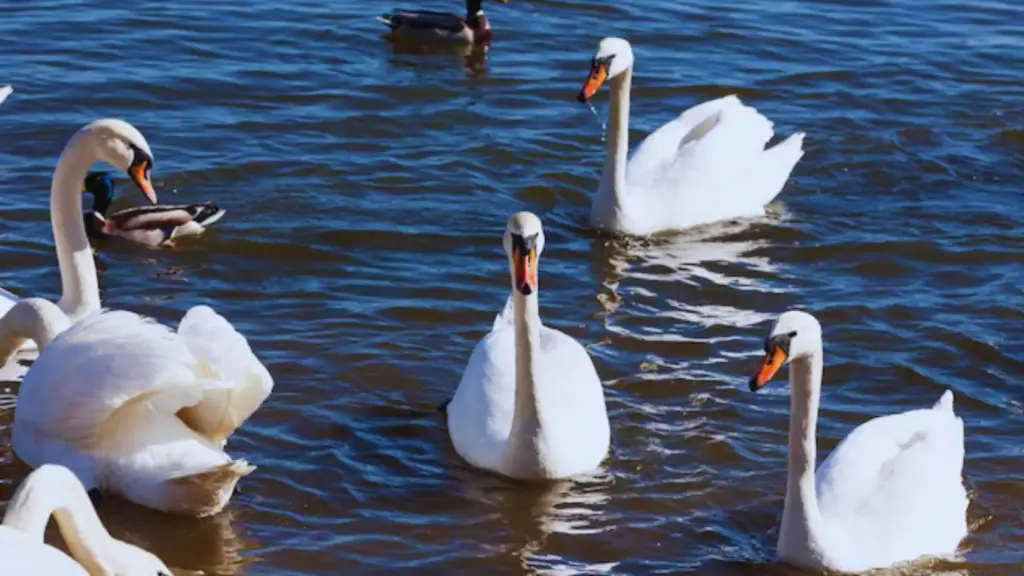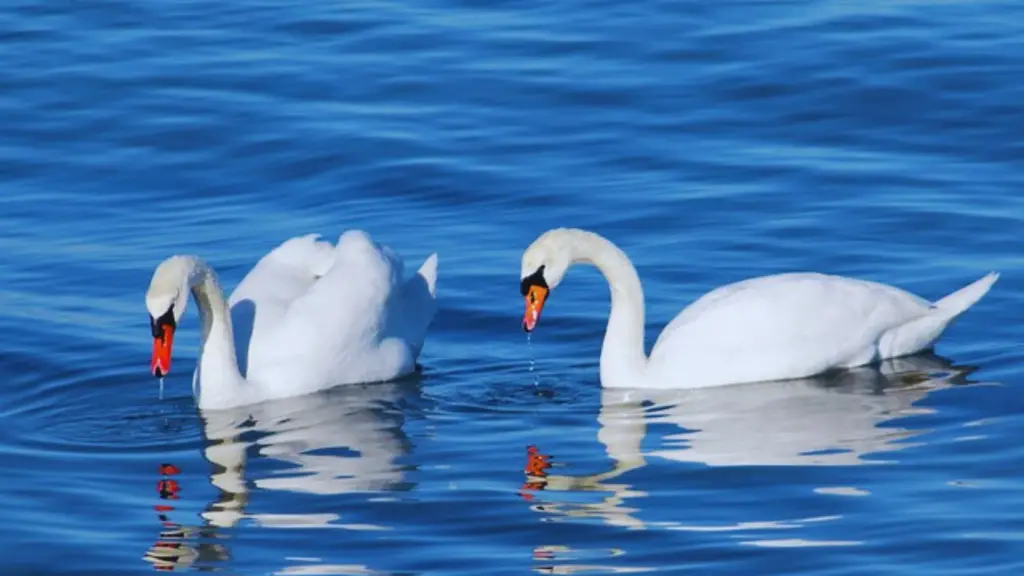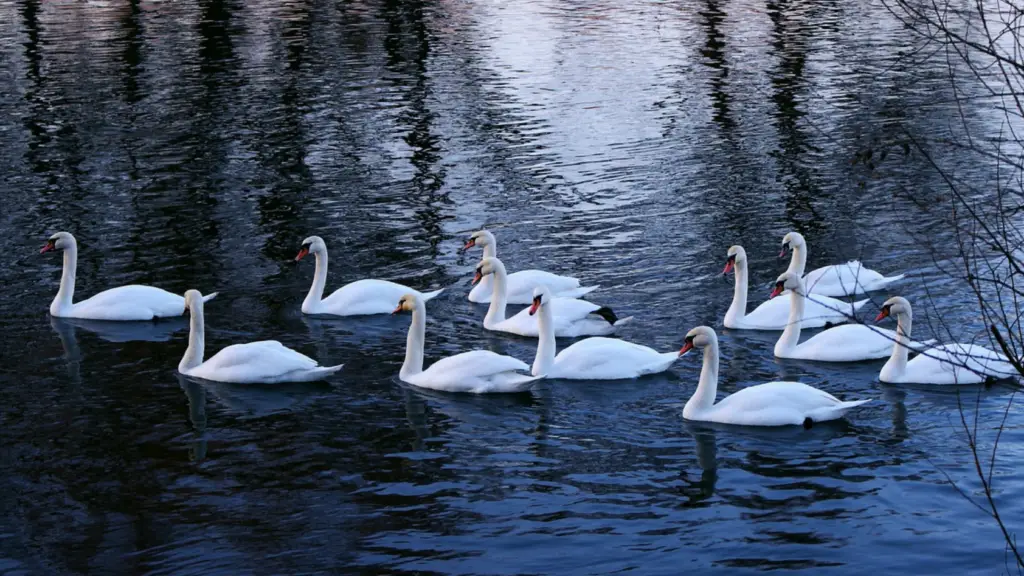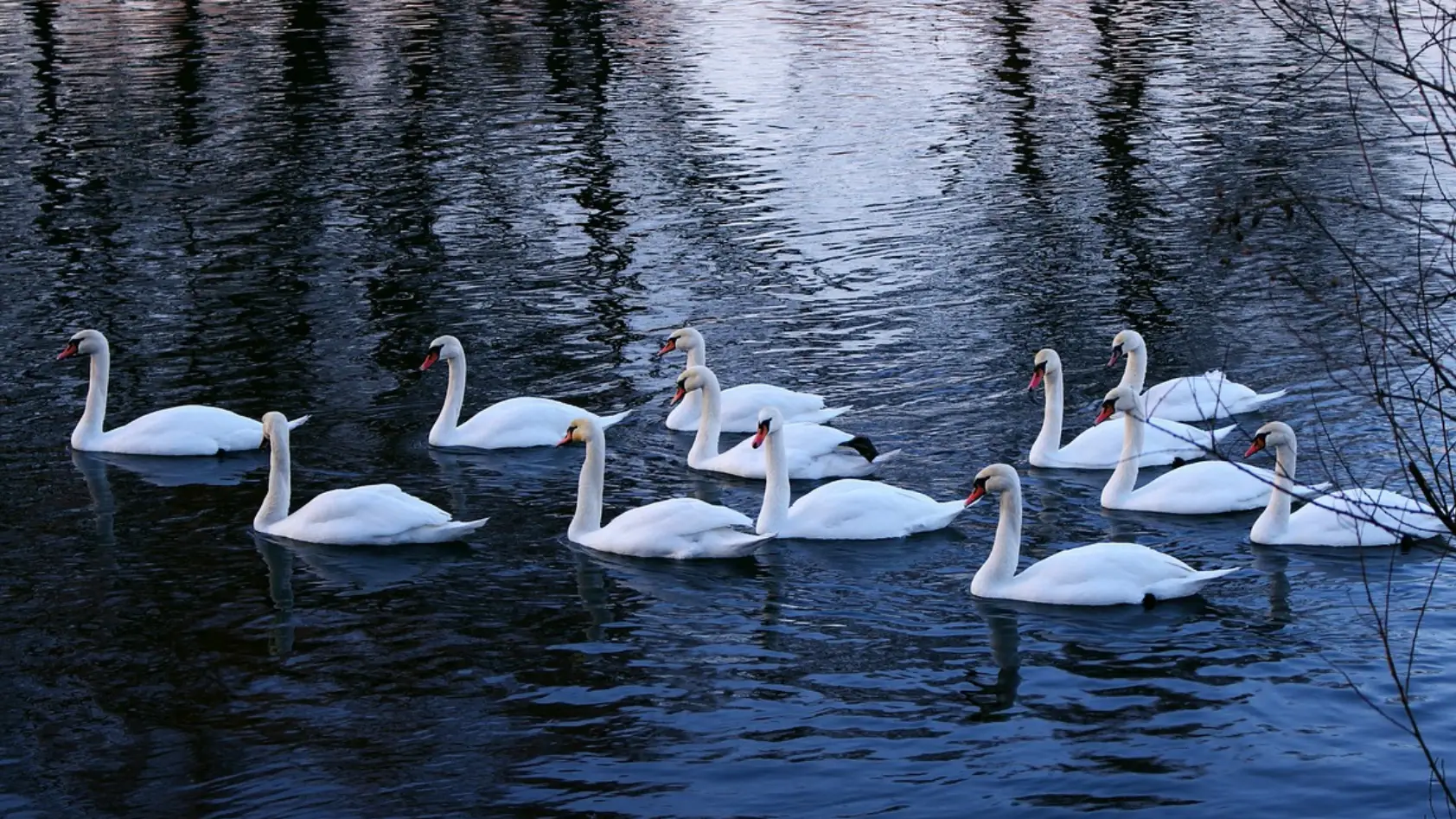Did you know that a group of swans is called a ‘bevy’? Well, now you do!
Imagine yourself standing by a tranquil water landscape, witnessing the breathtaking beauty of these graceful creatures coming together in a synchronized formation.
In this article, we will explore the enchanting world of swan gatherings and delve into the symbolism they hold in water landscapes.
You will learn about the mesmerizing movements of swans, as they glide effortlessly across the water, captivating all who witness their elegance.
Discover the importance of these serene environments for swan gatherings and gain insights into their behavior in group settings.
We will also delve into their nesting and parenting practices and explore how swans communicate through vocalizations.
Lastly, we will discuss conservation efforts aimed at protecting these majestic creatures and how photography can capture the serenity of swan gatherings.
Get ready for a journey into the world of swans and be prepared to be captivated by their grace and beauty.
Key Takeaways
- Swan formations showcase synchronized and precise movements, highlighting their intelligence and adaptability.
- Tranquil water landscapes are vital for swan gatherings as they provide calm, security, and enhance their natural beauty and elegance.
- Swan behavior in groups strengthens social bonds through synchronized swimming, communal feeding, and clear social hierarchies.
- Conservation efforts are crucial to protect swan populations from threats such as habitat loss, pollution, and hunting, and include habitat restoration, monitoring, and public awareness campaigns.
The Beauty of Swan Formations
The breathtaking beauty of swan formations is truly mesmerizing. As they glide through tranquil water landscapes, their movements are executed with precision and elegance. Each wing and body movement is effortlessly synchronized, creating a stunning visual display. It’s as if they were born to create these formations, moving with grace and harmony.
Their long necks are gracefully arched as they glide across the water’s surface. Moving as one entity, a group of swans in perfect harmony is a sight that is nothing short of magical. Their seamless movements and perfectly timed wing beats create a sense of tranquility and serenity.
Not only are swan formations aesthetically pleasing, but they also serve a practical purpose. Flying in formation helps conserve energy, as the lead bird breaks the wind, making it easier for the others to follow. This showcases their intelligence and adaptability.
Whether forming a straight line or a V-shape, swan formations are a true testament to the beauty and grace of these magnificent creatures. They remind us of the wonders of nature and the importance of working together in harmony. So, next time you find yourself near a tranquil water landscape, take a moment to appreciate the majestic beauty of swan formations – a true spectacle of nature’s artistry.
Symbolism of Swans in Water Landscapes
Surrounded by the serene beauty of their watery domain, it’s as if these elegant creatures were transported from another time, a reminder of the ethereal enchantment that can be found in nature’s embrace. Swans gracefully gliding through tranquil water landscapes hold a deep symbolism that captivates the imagination.
- The Symbol of Love: Swans are often associated with love and devotion, symbolizing the deep bond between partners. Their graceful formations in the water symbolize the unity and harmony found in loving relationships.
- The swan’s long, elegant neck represents loyalty and commitment, as these birds mate for life. Their devotion to their partners serves as a reminder of the strength and beauty of enduring love.
- The swan’s sleek white plumage represents purity and innocence, reflecting the purity of love and the hope it brings to our lives.
- The Symbol of Transformation:
- Swans undergo a remarkable transformation from cygnets to fully grown birds. This metamorphosis symbolizes personal growth, inner beauty, and the journey towards self-discovery.
- The swan’s ability to gracefully move through water represents adaptability and the ability to navigate through life’s challenges with elegance and poise.
- As swans effortlessly glide across the water, they remind us to embrace change and transformation, and to find beauty in the process.
- The Symbol of Peace:
- Swans are often associated with tranquility and peace. The peacefulness of their presence in water landscapes creates a sense of calm and serenity.
- The swan’s graceful movements and the gentle ripples they create on the water’s surface evoke a sense of harmony and balance.
- By observing the swans in their natural habitat, we are reminded to seek inner peace and find solace in the beauty of the world around us.
The symbolism of swans in water landscapes goes beyond their graceful formations. They represent love, transformation, and peace, reminding us of the deeper meanings that can be found in the natural world.
The Graceful Movements of Swans
Immersed in their serene watery domain, you cannot help but be captivated by the mesmerizing movements of these elegant creatures. The graceful movements of swans are a sight to behold, as they glide effortlessly across the tranquil waters. Their long, slender necks curve gracefully, while their powerful wings propel them forward with ease. With each stroke, they create ripples in the water, adding to the beauty of their dance.
As they swim, swans exhibit a sense of poise and balance that is truly remarkable. Their movements are smooth and fluid, as if they are performing a carefully choreographed ballet. They gracefully dip their heads into the water, searching for food, and then emerge with elegance, their feathers glistening in the sunlight. It is a joy to watch them as they gracefully navigate through the water, their every movement exuding grace and beauty.
Swans also have the ability to move gracefully on land. With their long legs and webbed feet, they waddle with a certain gracefulness that is endearing. Despite their size, they move with such elegance and precision, as if they are floating on air.
The graceful movements of swans are truly a marvel to witness. Whether in the water or on land, these elegant creatures captivate us with their poise, balance, and beauty. So, next time you find yourself in their presence, take a moment to watch them in awe as they glide through their watery domain, reminding us of the grace and tranquility that can be found in nature.
The Importance of Tranquil Water Environments for Swan Gatherings
Nestled within peaceful aquatic habitats, the serene environment plays a vital role in creating a harmonious gathering space for the elegant swans.
- Tranquil waters provide a sense of calm and tranquility that allows the swans to feel safe and secure. The absence of strong currents or disturbances ensures that the swans can glide gracefully through the water without any interruptions or obstacles.
- The stillness of the water enables the swans to engage in their graceful movements with ease. They can elegantly swim in synchronized formations, creating a mesmerizing sight for onlookers. The tranquil environment enhances their ability to showcase their natural beauty and elegance.
- The peaceful surroundings also contribute to the swans’ overall well-being. They can rest, groom, and socialize in a stress-free environment, fostering a sense of unity and harmony within the group. The absence of noise or disturbances allows them to communicate effectively and strengthen their social bonds.
The importance of tranquil water environments for swan gatherings cannot be overstated. These serene habitats provide the perfect backdrop for the swans to engage in their graceful movements, foster a sense of tranquility, and promote social cohesion within the group. So next time you come across a group of swans, take a moment to appreciate the importance of the tranquil water landscapes that make their gatherings so captivating.
Understanding Swan Behavior in Group Settings

In the midst of their elegant gatherings, it is fascinating to observe how swans interact and behave within their community settings. These graceful creatures exhibit a range of behaviors that contribute to the cohesion and harmony of the group. One notable behavior is their synchronized swimming, where they move in perfect unison, creating a mesmerizing spectacle. This synchronized swimming not only showcases their physical coordination but also strengthens the social bonds among them.
Another interesting behavior is their communal feeding. Swans often form a circle or a line in the water, creating a cooperative feeding strategy. This allows them to cover a larger area and increase their chances of finding food. It is truly a remarkable sight to see these majestic birds working together towards a common goal.
To further understand their behavior, let’s take a look at the table below:
| Behavior | Description |
|---|---|
| Synchronized Swimming | Swans move in perfect unison, showcasing their coordination and strengthening social bonds. |
| Communal Feeding | Swans form a circle or line in the water, increasing their chances of finding food. |
By observing these behaviors, we gain a deeper appreciation for the intricate social dynamics within a group of swans. Their graceful gatherings in tranquil water landscapes truly highlight the beauty of nature’s harmony.
The Social Hierarchy Within Swan Gatherings
Now that you have a better understanding of swan behavior in group settings, let’s dive deeper into the social hierarchy within their graceful gatherings.
Within a group of swans, there is a clear pecking order that determines their social standing. Just like in any society, some swans hold higher positions of power while others occupy lower ranks.
At the top of the hierarchy, you will find the dominant pair, also known as the alpha pair. This power couple leads the group and makes important decisions for the flock. They are respected and admired by the other swans, who follow their lead. Below them, there are other pairs of swans, each with their own level of authority.
The social hierarchy is maintained through various displays of dominance. The dominant swans assert their position by engaging in aggressive behaviors such as neck arching, hissing, and even physical attacks. Lesser-ranked swans quickly submit to these displays, ensuring the harmony and order within the group.
Understanding the social hierarchy within swan gatherings allows us to appreciate the complexity of their interactions. It is fascinating to observe how these majestic creatures establish and maintain their positions within the group.
So, next time you witness a group of swans gliding gracefully on tranquil waters, take a moment to appreciate the intricate social dynamics at play.
Swan Courtship and Mating Rituals

At the center of the swan social hierarchy, the alpha pair’s courtship and mating rituals captivate the flock, as they elegantly dance and intertwine their necks in a mesmerizing display of love and commitment. These rituals are not only a way for the alpha pair to strengthen their bond, but also a means of establishing their dominance within the group.
During courtship, the male swan will approach the female with his wings raised and head held high, displaying his strength and prowess. He may also engage in a series of head-bobbing movements and vocalizations to attract her attention. If the female is interested, she will respond by mirroring his movements and vocalizations. This synchronized dance serves as a way for the pair to communicate their mutual attraction and readiness to mate.
Once the courtship is successful, the pair will engage in a beautiful mating ritual that involves intertwining their necks and gracefully floating together in perfect harmony. This display not only showcases their bond but also serves as a visual spectacle for the rest of the flock. The table below summarizes the key elements of swan courtship and mating rituals:
| Ritual | Description |
|---|---|
| Courtship | – Male approaches female with wings raised and head held high – Head-bobbing movements and vocalizations to attract attention – Female mirrors movements and vocalizations |
| Mating | – Alpha pair intertwines necks and floats together in perfect harmony – Display of love and commitment – Mesmerizing spectacle for the flock |
In conclusion, swan courtship and mating rituals are a fascinating display of love and commitment within the flock. The alpha pair’s elegant dance and graceful movements captivate the attention of the entire group, solidifying their position at the center of the swan social hierarchy.
Nesting and Raising Young in Water Landscapes
Imagine yourself floating on a serene and gentle river, surrounded by the luscious greenery of the natural world. As you glide through the water, you notice a group of swans gracefully gliding alongside you. These majestic creatures are nesting and raising their young in this tranquil water landscape.
Swans are known for their dedication to their offspring. The female swan, or pen, carefully selects a nesting site, usually on an island or in a secluded area near the water’s edge. She builds a large nest made of reeds, grass, and other vegetation, creating a safe and comfortable environment for her eggs.
Once the nest is complete, the pen lays her eggs, usually around 4 to 7 in number. Both the pen and the male swan, or cob, take turns incubating the eggs, ensuring they stay warm and protected. This shared responsibility allows each swan to take breaks and feed, ensuring their own health and the success of their offspring.
After about 35 to 41 days, the eggs hatch, and the young cygnets emerge. These fluffy and adorable creatures are cared for by both parents, who teach them how to swim, find food, and protect themselves from predators. The family unit stays together until the cygnets are old enough to venture out on their own.
As you continue to float along the river, you realize the beauty and harmony of a swan family. Their dedication to one another and their peaceful existence in water landscapes make them a truly remarkable sight to behold.
Swan Communication and Vocalizations
Floating on a serene river, you can’t help but be captivated by the melodious communication and vocalizations of these majestic creatures. Swans are known for their distinct vocalizations, which play a crucial role in their social interactions and bonding. Here are four fascinating aspects of swan communication:
- Trumpeting Calls: Swans produce a series of loud, trumpet-like calls, which can be heard from a considerable distance. These calls serve as a means of communication between individuals and can convey messages related to territory defense, warning signals, or courtship rituals.
- Hissing and Snorting: Swans also communicate through hissing and snorting sounds. Hissing is often used as a defensive mechanism to intimidate intruders or predators, while snorting is a way of expressing agitation or annoyance.
- Whispering Calls: In contrast to their powerful trumpeting calls, swans also produce soft, whispering calls. These gentle vocalizations are usually reserved for close communication between mates or family members and are used to express affection and reassurance.
- Wing Beating: Another unique form of swan communication is through the rhythmic beating of their wings on the water’s surface. This behavior creates a distinctive sound that can attract attention and signal the presence of a swan or a group.
The rich vocal repertoire of swans adds an enchanting dimension to their graceful gatherings in tranquil water landscapes, making them even more captivating to observe.
Conservation Efforts to Protect Swan Populations

Conservation efforts have been implemented to safeguard the populations of these majestic creatures. Swan populations are facing numerous threats, including habitat loss, pollution, and hunting. To address these challenges, conservation organizations and government agencies have been working tirelessly to protect and preserve swan populations.
One key conservation effort is the establishment of protected areas for swans. These areas provide a safe haven for the birds, free from disturbance and human activities that could harm them. By designating these protected areas, swans have a place to rest, feed, and breed without fear of disruption.
Another important conservation measure is the monitoring of swan populations. Researchers and volunteers track the number of swans in different regions to assess their overall health and well-being. This information helps identify any declines in population numbers and allows for targeted conservation actions to be taken.
In addition to protection and monitoring, efforts are also being made to restore and enhance swan habitats. This can involve restoring wetlands, removing invasive species, and planting native vegetation that provides food and shelter for swans. By improving their habitats, swans are better equipped to survive and thrive.
Conservation also extends to education and public awareness campaigns. By educating the public about the importance of swans and their habitats, people can become more mindful of their actions and make choices that benefit these beautiful creatures.
Overall, these conservation efforts are crucial for the long-term survival of swan populations. With continued dedication and support, we can ensure that these graceful birds continue to grace our tranquil water landscapes for generations to come.
Capturing the Serenity of Swan Gatherings in Photography
As the camera clicks, time seems to pause, capturing the ethereal dance of white feathers and gentle ripples, immortalizing the serenity of these majestic creatures coming together. Swan gatherings provide a mesmerizing spectacle that photographers strive to capture.
With their graceful movements and tranquil water landscapes as a backdrop, these gatherings offer a unique opportunity to capture the beauty and tranquility of nature.
To capture the serenity of swan gatherings, photographers need to approach with patience and respect. Observing from a distance allows the swans to feel comfortable and ensures their natural behavior is not disturbed. The aim is to capture the swans in their most natural state, creating images that evoke a sense of peace and tranquility.
The lighting also plays a crucial role in capturing the serenity of these gatherings. Soft, diffused light enhances the delicate features of the swans, highlighting their elegant forms against the water’s reflection. Photographers often choose early morning or late evening when the light is at its most gentle and golden.
Composition is another vital aspect of capturing the serenity of swan gatherings. Framing the swans against the vastness of the water or using leading lines to guide the viewer’s eye towards the focal point can create a sense of harmony and balance in the photograph.
In conclusion, photographing swan gatherings allows one to freeze moments of serenity and create images that encapsulate the beauty of these graceful creatures. With patience, respect, and careful attention to lighting and composition, photographers can capture the ethereal dance of white feathers, forever preserving the tranquility of these gatherings.
Group of Swans FAQs
How can I contribute to the conservation efforts to protect swan populations?
You can contribute to swan conservation efforts by supporting organizations focused on protecting their habitats, volunteering for swan monitoring programs, spreading awareness about their importance, and practicing responsible behavior near their habitats.
What are some common vocalizations and communication methods used by swans?
Swans use a variety of vocalizations and communication methods. They can honk, hiss, trumpet, and even make a soft cooing sound. They also communicate through body language, such as head bobbing and wing flapping.
Can swans form groups with other bird species in water landscapes?
Yes, swans can form groups with other bird species in water landscapes. While they are known for their elegance, swans are also social creatures that often gather with ducks, geese, and other waterfowl.
Do swans migrate to different water landscapes during different seasons?
Yes, swans migrate to different water landscapes during different seasons. They move to find suitable habitats for breeding and feeding. Migration allows them to adapt to changing environmental conditions and ensure their survival.
Are there any specific swan behaviors that indicate their social hierarchy within gatherings?
Swans display specific behaviors that indicate their social hierarchy within gatherings. They engage in aggressive displays, such as fluffing their feathers and hissing, to establish dominance. Lower-ranked swans may retreat or submit to higher-ranked individuals.
Conclusion
So next time you find yourself near a tranquil water landscape, keep an eye out for a group of swans gracefully gliding through the water. These elegant creatures are not only beautiful to watch, but they also play a vital role in their ecosystems.
Did you know that there are over 10,000 species of swans worldwide? It’s truly fascinating to think about the diversity and impact of these majestic birds.
So take a moment to appreciate the serenity of swan gatherings and the importance of preserving their habitats.













